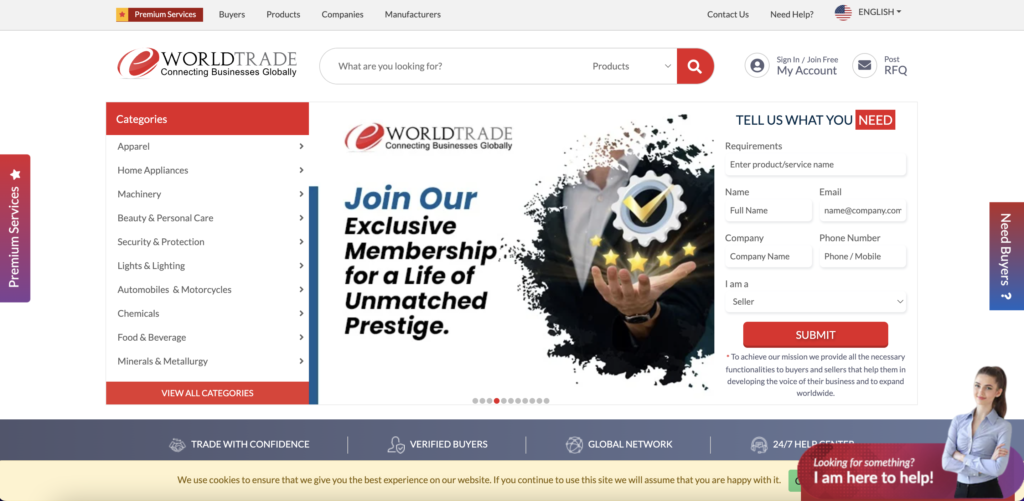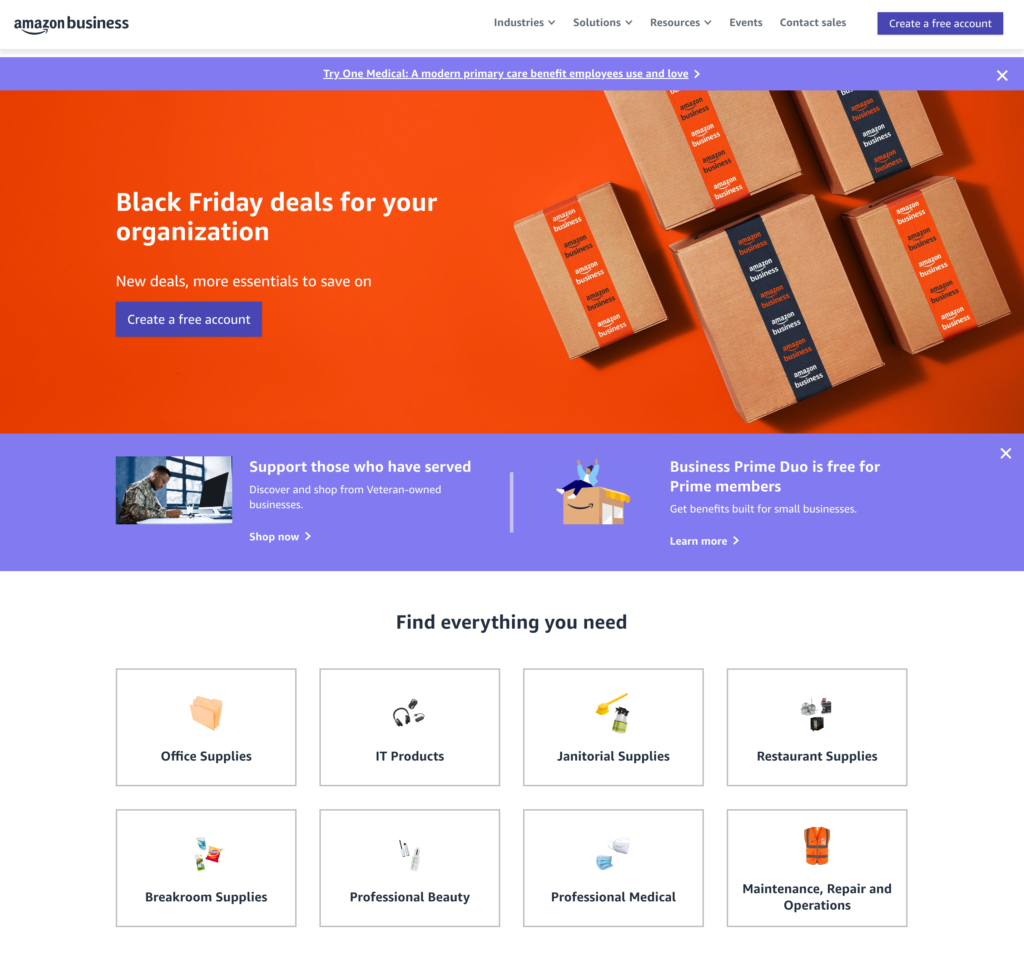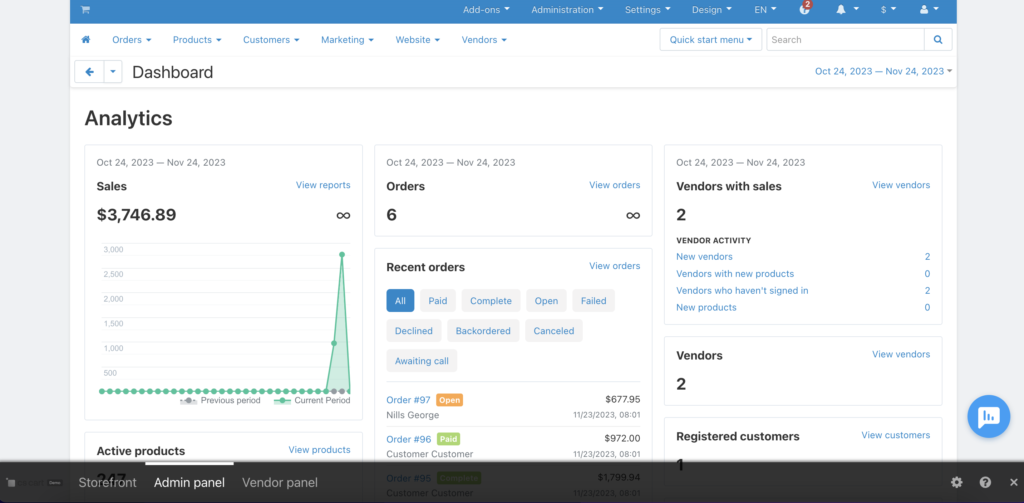B2B Marketplace Mastery: Platforms, Building Guide, and Success Principles
Today’s B2B eCommerce Landscape
The global business-to-business (B2B) eCommerce landscape is experiencing a transformative surge, mirroring the success of global marketplace unicorns such as Airbnb, Etsy, and Thumbtack. Traditionally slower to embrace change, B2B markets are now rapidly adapting, ushering in a new era marked by digital interactions and thriving online platforms.
In 2021, the global B2B eCommerce market reached an astonishing $17.9 trillion, eclipsing its business-to-consumer (B2C) counterpart by over five times. This surge is not just a numerical increase; it signifies a paradigm shift, with a remarkable $5 trillion growth from the $12.2 trillion estimated in 2019. Gartner’s forward-looking projections suggest that, by 2025, a substantial 80% of B2B sales interactions will transpire in digital channels, underscoring the accelerated migration towards online platforms.
B2B Marketplaces: A Gateway for Business Growth
Small and medium-sized enterprises (SMEs) are increasingly recognizing the potential of B2B marketplaces as powerful online platforms seamlessly connecting businesses to other businesses. These marketplaces facilitate efficient product listings on wholesale portals, fostering connections with B2B customers and driving business growth. As a testament to this trend, forecasts predict that by the end of 2023, B2B eCommerce marketplaces will contribute $1.8 trillion in sales, constituting 17% of all B2B sales.
A McKinsey report further emphasizes this shift, revealing that approximately 65% of diverse B2B enterprises conducted their entire business online in 2022. This statistic not only underscores the significance of B2B marketplaces but also foretells their potential expansion as integral components of global marketplace dynamics.
Seamless Integration and Global Marketplace Dynamics
As B2B eCommerce marketplaces evolve, they offer a diverse array of features and capabilities, empowering merchants to streamline their business operations seamlessly. This evolution is vital for businesses aiming to bridge their existing eCommerce stores with the dynamic world of B2B markets.
One noteworthy aspect is the global marketplace dynamics, where businesses can connect with other businesses worldwide, fostering a truly global reach. The importance of a robust marketplace platform cannot be overstated, as it acts as the conduit for fruitful business-to-business interactions. These platforms facilitate not only seamless integration but also pave the way for expansive business growth by providing secure payment processing options.
What to Expect in This Comprehensive Guide
This article serves as a comprehensive guide, providing businesses with valuable insights into the dynamic realm of B2B eCommerce marketplaces. It explores current trends, vital statistics, and methods for seamlessly integrating existing eCommerce stores with B2B markets. Crucially, the guide showcases the top 10 B2B marketplaces, elucidating their key benefits and underscoring their role in fostering global business growth in an interconnected and rapidly evolving digital landscape.
In This Guide:
- What’s a B2B Marketplace?
- What Is the Difference Between a B2B and a B2C Marketplace?
- Selling Through B2B Marketplaces: The Benefits and Downsides
- What Are Some Examples of Successful B2B Marketplaces?
- What Is the Best Platform for Building a B2B Marketplace?
- Crafting Your B2B Marketplace: Strategies for Success
What’s a B2B Marketplace?
A B2B marketplace, or business-to-business marketplace, serves as the digital nexus exclusively linking companies for the exchange of products, services, or rentals. In sharp contrast to peer-to-peer (P2P) marketplaces and business-to-consumer (B2C) platforms, B2B marketplaces are finely tuned to streamline complex, large-scale business transactions, catering exclusively to the intricate needs of companies and organizations.
Specialized Transactions in a Business-Driven Realm
One of the defining features of B2B marketplaces is their exclusive focus on facilitating transactions between businesses. These transactions encompass a spectrum of products, services, and rentals, providing a tailored space for companies to engage in commerce that goes beyond the scope of individual customers. Unlike traditional consumer-centric platforms, B2B marketplaces excel at accommodating bulk purchases and navigating the complexities of internal procurement procedures.
Diverse Categories: Vertical vs. Horizontal B2B Marketplaces
B2B marketplaces can be broadly categorized into two main types: vertical and horizontal. Vertical marketplaces carve a niche by specializing in specific product or service types, such as software development or office space rentals. On the other hand, horizontal marketplaces offer a diverse array of categories, providing a one-stop-shop for a wide range of business needs. A prime example of the latter is Amazon Business, a notable B2B eCommerce marketplace.
Beyond Transactions: The Role of B2B Marketplaces
More than mere transactional platforms, B2B marketplaces function as comprehensive eCommerce ecosystems tailored to meet the unique demands of inter-business commerce. These platforms facilitate the entire shopping process, empowering businesses to procure goods and services from other businesses at competitive prices, with flexible delivery times, and in quantities that transcend the limitations of traditional shopping methods.
Global Connectivity and Local Success Stories
The beauty of B2B marketplaces lies in their ability to foster connectivity on a global scale while still nurturing successful local marketplaces. By providing a space for companies to connect with suppliers within their industry, access pertinent business information, and seamlessly compare services and products, B2B marketplaces serve as dynamic hubs for business growth and collaboration.
Building Bridges with Multi-Vendor Marketplaces
A key facet of B2B marketplaces is their role as multi-vendor platforms, connecting buyers and sellers within a centralized online marketplace. This dynamic interplay not only streamlines the supply chain but also opens avenues for businesses to sell products on a broader scale. The concept of multi-vendor marketplaces embodies the collaborative spirit, where businesses, large and small, converge on a shared online platform, fostering a thriving ecosystem of commerce.
The Heart of Ecommerce: Payment Processing and Potential Customers
Critical to the functionality of B2B marketplaces is the seamless integration of payment processing systems. This ensures secure transactions and facilitates the smooth flow of commerce within the platform. As businesses connect with potential customers on these online marketplaces, the ability to handle transactions efficiently becomes a linchpin for success. B2B marketplaces not only connect buyers and sellers but also serve as secure conduits for financial transactions, bolstering trust and confidence in the digital business landscape.
What Is the Difference Between a B2B and a B2C Marketplace?
Understanding the nuances between Business-to-Business (B2B) and Business-to-Consumer (B2C) marketplaces is pivotal for businesses seeking to thrive in the diverse landscape of online commerce, especially within the dynamic realm of the B2B marketplace. Each model caters to distinct needs, and recognizing these differences is essential for crafting a tailored strategy.
1. Target Audience and Customer Dynamics in the B2B Marketplace
B2B Marketplaces: Focused Business Relationships
In the B2B marketplace, the primary focus is on facilitating transactions between businesses. The target audience comprises professionals, enterprises, and organizations looking to source raw materials, products, or services at a larger scale within the B2B marketplace. The customer dynamics revolve around building long-term relationships, negotiating contracts, and accommodating the complexities of corporate procurement.
B2C Marketplaces: Individual Consumer Engagement
Conversely, B2C marketplaces within the broader spectrum of the B2B marketplace center around individual consumers. These platforms aim to create seamless, personalized experiences for end-users. The focus is on convenience, user-friendly interfaces, and personalized interactions to appeal to the diverse preferences of individual customers.
2. Transaction Scale and Volume in the B2B Marketplace
B2B Marketplaces: Bulk Purchases and Complex Transactions
B2B transactions within the specialized B2B marketplace often involve bulk purchases of raw materials and intricate negotiations. The scale is larger, with businesses procuring goods or services in quantities that cater to their operational demands within the B2B marketplace. The procurement process is more complex, addressing the specific needs of businesses and the intricacies of supply chain management.
B2C Marketplaces: Individual Transactions and Varied Scale
In contrast, B2C transactions within the comprehensive B2B marketplace are typically smaller in scale, catering to the individual needs of consumers. These transactions often involve businesses selling products individually, and the emphasis is on providing a seamless and enjoyable shopping experience for the end consumer within the broader B2B marketplace.
3. Decision-Making Processes in the B2B Marketplace
B2B Marketplaces: Collaborative Decision-Making
B2B purchases within the collaborative B2B marketplace involve a collaborative decision-making process. Multiple stakeholders within a business, such as procurement teams, executives, and decision-makers, contribute to the decision-making process. The emphasis is on meeting the business’s operational requirements and ensuring a positive return on investment within the B2B marketplace.
B2C Marketplaces: Individual Consumer Choice
In B2C marketplaces within the encompassing B2B marketplace, the decision-making process is largely individual-centric. Consumers make choices based on personal preferences, reviews, and the overall appeal of products or services. The goal is to capture the attention and loyalty of individual consumers through effective marketing and product presentation within the broader B2B marketplace.
4. Marketing and Branding Strategies in the B2B Marketplace
B2B Marketplaces: Relationship Building and Trust
B2B marketing strategies within the B2B marketplace revolve around relationship-building and establishing trust. Content marketing, thought leadership, and building a solid reputation within the industry are crucial within the B2B marketplace. The sales cycle is longer, necessitating ongoing engagement to foster trust and credibility within the comprehensive B2B marketplace.
B2C Marketplaces: Consumer-Focused Branding
In contrast, B2C marketing within the encompassing B2B marketplace places a strong emphasis on consumer-focused branding. Strategies include targeted advertising, influencer collaborations, and creating emotional connections with the audience. The sales cycle is generally shorter, and the focus is on immediate conversion and customer satisfaction within the broader B2B marketplace.
5. User Experience and Interface Design in the B2B Marketplace
B2B Marketplaces: Functionality and Efficiency
B2B marketplace interfaces within the B2B marketplace prioritize functionality and efficiency, enabling businesses to achieve cost savings. The design often caters to the specific needs of businesses, providing tools for bulk ordering, customizable catalogs, streamlined procurement processes, and efficient order form templates that facilitate seamless transactions within the B2B marketplace.

B2C Marketplaces: User-Friendly and Aesthetic
In contrast, B2C marketplace interfaces within the comprehensive B2B marketplace prioritize user-friendliness and aesthetics. The emphasis is on creating an enjoyable and intuitive shopping experience, with visually appealing layouts, personalized recommendations, and easy navigation within the broader B2B marketplace.
Recognizing the differences between B2B and B2C marketplaces is fundamental for businesses aiming to navigate the complexities of online commerce successfully, especially within the dynamic realm of the B2B marketplace. Whether engaging in large-scale B2B transactions, facilitating cost savings, or catering to the individual preferences of B2C consumers, tailoring strategies to align with the specific dynamics of each model is key to sustained success in the evolving digital marketplace.
All the essential features, including multiple payment systems, marketplace software, and a robust product information management system, play crucial roles in enhancing the overall experience for both marketplace operators and the diverse array of business buyers, including small businesses. Moreover, in the era of the digital marketplace, these features ensure seamless transactions and streamlined processes, contributing to the success of businesses across the online commerce landscape in the B2B marketplace.
Selling Through B2B Marketplaces: The Benefits and Downsides
In the dynamic landscape of online commerce, choosing where to sell is a pivotal decision for businesses seeking to enhance their reach and streamline their operations. Whether leading the charge in Fast-Moving Consumer Goods (FMCG) eCommerce or dealing in high-value transactions, the selection of the right B2B marketplace can be a game-changer. In this section, we’ll explore both the benefits and downsides of selling on a B2B marketplace, encompassing a wide array of crucial keywords.

Benefits of Selling on a B2B Marketplace
1. Access to a Larger Customer Base
- Expand your reach to new and potential customers globally.
- Increased sales and higher profits through a broader audience.
2. Increased Reach to Other Businesses
- Tap into a vast audience of potential B2B buyers.
- Enhanced exposure leading to increased sales and higher profits.
3. Reduced Marketing Costs
- Embrace a cost-effective solution, leveraging built-in digital marketing efforts.
- Efficiently reach potential buyers without breaking the bank.
4. Streamlined Sales Process
- Utilize a centralized platform for showcasing products, managing orders, and inventory.
- Experience a smoother and more efficient sales process for enhanced productivity.
5. Improved Customer Trust
- Build credibility by listing products on trusted B2B eCommerce platforms.
- Establish reliability, leading to increased sales and a positive reputation.
6. Increased Product Visibility
- Enhance visibility for products, making it easier for buyers to find and purchase.
- Showcase products in a user-friendly manner, increasing the chances of making a sale.
7. Ease of Use
- Benefit from a user-friendly design for easy listing, sales management, and audience reach.
- Enjoy a convenient option for businesses looking to grow with simplicity.
8. Access to Market Data and Insights
- Gain valuable market data and insights for informed business decisions.
- Understand industry trends for better decisions on products, pricing, and marketing.
9. Payment Processing
- Explore payment processing options through versatile payment hubs.
- Facilitate multiple payment systems, converted into local currency for faster and easier transfers.
10. Enhanced Security
- Rely on comprehensive security measures to safeguard personal and financial information.
- Ensure safe and secure transactions for both buyers and sellers.
Downsides of B2B Marketplace Selling
1. Dependence on the Marketplace
- Rely on the platform for customer acquisition.
- Navigate potential changes in policies, added fees, or technical issues impacting sales.
2. Limited Customization Options
- Operate within strict guidelines, limiting customization of product listings and descriptions.
- Businesses may find options limited to suit their specific needs.
3. Data Security Concerns
- Address concerns about sharing sensitive information, posing risks in case of data breaches.
- Prioritize the security of customer data, payment details, and product information.
4. Competition and Price Pressure
- Navigate a highly competitive environment that may lead to price pressure.
- Overcome challenges in maintaining profitability while offering competitive prices.
5. Lack of Control Over Brand Image and Reputation
- Manage with limited control over how the brand is presented to potential customers.
- Address reliance on the platform for promotion, impacting brand image and reputation.

In the multi-faceted world of B2B marketplaces, where businesses sell products and operate within a digital platform, the small businesses thrive by navigating a consumer-to-consumer environment. The sales process, customer data, and marketing costs are intricately woven into the same platform, offering opportunities for businesses to operate at wholesale prices, connecting them directly with wholesale suppliers for resellers.
This unique business model caters to various stakeholders, including the marketplace operator, and facilitates transactions at wholesale prices, creating a robust ecosystem for small businesses within the expansive realm of ecommerce platforms.
What Are Some Examples of Successful B2B Marketplaces?
In the dynamic realm of B2B commerce, numerous marketplaces have ascended to prominence, serving as indispensable conduits for businesses seeking seamless transactions. Here’s a concise overview of some thriving B2B marketplaces:
Amazon Business—Global Powerhouse in B2B:
- Amazon Business, a global B2B eCommerce giant, is projected to reach $83 billion in GMV by 2025.
- Noteworthy benefits include a vast global audience, low marketing costs, and leveraging Amazon’s reputation and supply chain network.
- However, challenges arise from high competition, limited control, and category restrictions, emphasizing the need to meet customer expectations.
Alibaba—Global Hub for B2B Transactions:
- Alibaba, a global B2B eCommerce hub, boasts subsidiaries like Taobao and Tmall.
- Its strengths lie in a global network of retailers, verified brand profiles, and an extensive range of products available in large quantities.
- However, fierce competition, longer shipping times, and lower profit margins necessitate a focus on transparent pricing strategies.
Faire—Empowering Independent Retailers:
- Faire stands out as a leading online wholesale marketplace, offering an eCommerce platform tailored for independent retailers.
- The benefits extend to a straightforward setup, extended payment terms, and seamless integration.
- Careful consideration of commission fees and consistent pricing across multiple vendors is crucial.
Novi—Elevating Sustainability in B2B:
- Novi, a new entrant, focuses on clean and transparent products.
- Pros encompass connections with like-minded retailers, credibility in sustainability, and an extensive range of products.
- Challenges include a smaller market size, necessitating a careful understanding of customer expectations.
Ankorstore—Facilitating European Connections:
- Ankorstore connects European independent buyers and sellers through its eCommerce platform.
- Advantages include flexible payment terms, control over wholesale pricing, and robust support services for managing inventory.
- Limitations, such as registration exclusivity and minimum order values, emphasize the need for transparent pricing structures.
Abound—Niche Marketplace for Indie Businesses:
- Abound caters to indie businesses, specializing in handmade goods, offering a diverse eCommerce platform.
- Advantages include no selling fees, verified retailers, and comprehensive support services.
- Challenges, including a competitive application process and shipping limitations, highlight the importance of transparent pricing.

In this dynamic B2B landscape, each marketplace plays a crucial role in the broader eCommerce ecosystem. Understanding the nuances of these platforms is essential for businesses aiming to meet customer expectations, efficiently manage inventory, and navigate the intricacies of transparent pricing within the world of B2B commerce.
What Is the Best Platform for Building a B2B Marketplace?
Embarking on a journey into the world of B2B eCommerce necessitates a keen understanding of the diverse marketplace platforms available. Let’s delve into some prominent options and explore the platforms for building an online marketplace:
CS-Cart—Elevating Businesses Through Multi-Vendor Dynamics:
- Introduction: Established in 2005, CS-Cart is a renowned multi-vendor marketplace platform designed for enterprises with complex requirements.
- Features: CS-Cart offers a customizable storefront, advanced admin panel, and integrations with major shipping and payment services.
- Pricing: While the B2C package incurs recurring charges, the B2B-specific solution operates on a Request For Quote basis, ensuring flexibility for businesses.

Magento—A Decade of Empowering Ecommerce Ventures:
- Introduction: Since 2008, Magento has stood as a robust multi-vendor marketplace solution catering to businesses of varied scales.
- Features: With features like custom coupon creation, SEO management, and PCI-DSS compliance, Magento facilitates seamless e commerce experiences.
- Pricing: While the open-source version is free, Magento Commerce starts at $1988/month, providing a scalable solution with diverse pricing options.
OroMarketplace—Tailored for B2B Excellence:
- Introduction: OroMarketplace is a flexible B2B e-commerce platform designed to navigate the complexities of enterprise-level business transactions.
- Features: Efficient customer management functionalities, CRM systems, and support for legacy system integrations characterize OroMarketplace.
- Pricing: Pricing for OroMarketplace is available via Request For Quote, allowing businesses to tailor their investment based on specific needs.
Mirakl—A Versatile SaaS Platform for Dynamic Commerce:
- Introduction: Developed by a France-based company, Mirakl serves as a versatile SaaS e-commerce platform supporting both B2B and B2C business models.
- Features: Supporting multiple monetization channels and boasting an advanced product recommendation engine, Mirakl caters to dynamic multi-tenant operations.
- Pricing: Mirakl’s pricing details are available via Request For Quote, ensuring businesses can align their investment with the platform’s offerings.
PrestaShop—Open-Source Empowerment Since 2007:
- Introduction: Since 2007, PrestaShop has provided a free, open-source solution for businesses ranging from mid to large scale.
- Features: Offering features like inventory management, multi-channel marketing, and advanced SEO, PrestaShop is a versatile e commerce platform.
- Pricing: While PrestaShop is 100% free, businesses should be mindful of potential costs for modules, add-ons, and integrations.
Choosing the right marketplace platform entails careful consideration of features, pricing structures, and user experiences. Each solution, whether multi-vendor or tailored for B2B e-commerce, caters to unique needs, empowering businesses in their digital endeavors without compromising on their monthly fees and overall operational efficiency.
Crafting Your B2B Marketplace: Strategies for Success
Launching a B2B marketplace demands careful consideration of the development approach. Here, we explore the three primary methods—coding from scratch, leveraging no-code tools, and adopting headless software—each offering unique advantages and considerations.
1. Custom-Develop Your B2B Marketplace from Scratch:
Pros:
- Flexibility: Design the platform to your exact specifications.
- Unique Features: Tailor the marketplace for distinct offerings.
Cons:
- Costs: Substantial upfront expenses, exceeding $50,000.
- Time Demands: Extended development timelines.
- Maintenance: Ongoing costs for hosting, tools, and updates.
2. Build and Launch Fast with No-Code B2B Software:
Pros:
- Speed: Expedite launch with a no-code marketplace builder.
- Cost-Efficiency: Lower initial costs, ideal for MVP.
- Ease of Use: Suitable for non-technical founders.
Cons:
- Limited Functionality: May not meet all B2B marketplace requirements.
- Scaling Challenges: Gaps in functionality as the user base grows.
3. Custom-Develop on Top of an API-Based B2B Marketplace Solution:
Pros:
- Efficiency: Benefit from core marketplace features without coding.
- Cost Savings: Up to 90% reduced development costs compared to scratch.
- Control: Merge advantages of custom development and no-code tools.
Cons:
- Technical Skills: Requires a higher level of technical proficiency.
- Time Commitment: More involved than fully no-code solutions.
- Learning Curve: Understanding API-based development nuances.
Choosing the Right Path for Your B2B Ecommerce Platform:
- Minimum Viable Platform (MVP): Initiate your marketplace with an MVP addressing core user concerns.
- Cost Considerations: Weigh upfront expenses, ongoing costs, and founder time commitment.
- Balancing Act: Balance flexibility, speed, and cost-effectiveness in line with your business goals.
- Continuous Evolution: Regardless of the chosen path, your B2B ecommerce platform should evolve based on user feedback and market dynamics.
Expanding Horizons with Your B2B Ecommerce Platform:
- New Customers: Attracting new customers is pivotal for marketplace growth.
- New Markets: Explore opportunities in untapped markets for increased reach.
- Customer Experience: Prioritize a seamless and positive experience for end consumers.
- Global Sources: Leverage global sources to diversify and enrich your marketplace.
- Large Corporations: Target large corporations as potential key players in your B2B ecosystem.
Yan Anderson is the Head of Content Marketing at CS-Cart with over 10 years of experience in the eCommerce industry. He's passionate about explaining complicated things in simple terms. Yan has expertise in building, running and growing eCommerce marketplaces. He loves to educate people about best practices, new technologies, and trends in the global eCommerce industry.

